Introduction
The Assamese Gamocha, pronounced ‘gamusa’ is the traditional cultural textile of Assam. A handloom rectangular cloth weaved with white and red threads containing different motifs and symbols, the gamusa is widely recognized as the cultural expression of the Assamese people. Coming from the Assamese word ‘ga’ meaning ‘body’ and ‘musa’ meaning ‘to wipe’, this garment is similar to a towel, but is multifunctional and a product of pride and cultural reverence, significant to the Assamese culture.
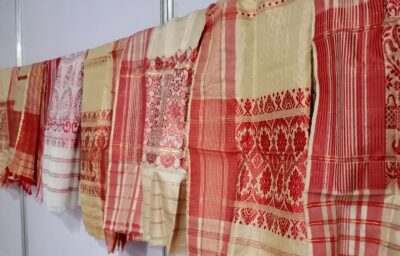
Origin and Legacy
While deeply rooted in Assam’s local heritage, the exact genesis of this textile is a subject of debate among the historians. It is considered to have existed in a different texture that gradually evolved over time and acquired its present identity.
Some legends trace its origin to the arrival of the people from the Alpine region before the 12th century. Historical accounts also suggest that gamusa existed during the reign of the Ahom Dynasty, where historians link its origin to the reign of popular Ahom ruler Siu-ka-pha.
The Vaishnavite and Neo-Vaishnavite movement led by Saint Sankardeva from the 14th century also witnessed the usage of red-bordered gamusas adorned by male followers on different occasions. Additionally, a group of historians also asserts its origin to Thailand, where a similar cloth is crafted, but it is also not clearly confirmed.
Weaving Techniques of the Gamusa
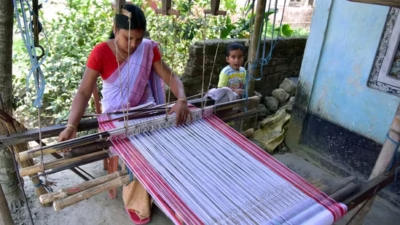
Weaving the gamusa is a skilled craft, mastered over generations by handloom weavers. It demands utmost precision, care and patience. A simple traditional gamusa is a rectangular cloth woven particularly from cotton yarn. Depending on its uses and occasion, gamusas are sometimes woven from more luxurious materials such as the Muga silk, Tussar silk and Mulberry silk—giving it more lustre and elegance.
Natural dyes were used to make yarn of different colors in earlier times. The red dye used to make the borders of the gamusa was obtained from the roots and bark of the Achu tree (Morinda angustifolia). Additionally, leaves of the guava plant were employed as a mordant, which acted as a substance that helped fix the dye to the yarn, thereby enhancing the richness and longevity of the colour.
Types of Assamese Gamusa
Depending upon their use, there are various kinds of gamusa found in Assam, which includes
Uka gamusa—Uka means ‘empty’; therefore, this gamusa consists of a simple plain design, with stripes of red threads used in its two borders. It is mostly used as an everyday utility towel, found in every Assamese household.
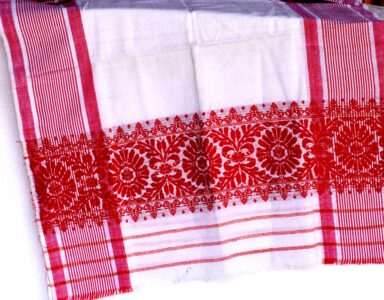
(Source: Assam State Rural Livelihood Mission)
Phulaam gamusa—meaning ‘flowery’ gamusa—contains elaborate designs and motifs. This cloth is used as a token of love and respect bestowed as a gift on special occasions especially during Bohag Bihu (Assamese New Year). Also known as ‘bihuwaan,’ it is worn by men as a scarf or a stole for ritualistic purposes; some wear them while working out in the fields for agricultural work and as headgear by the men while performing bihu.
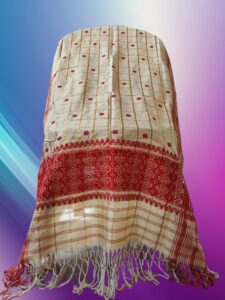
(Source : Asomi Cart)
Anakata gamusa—meaning ‘without a cut’—is the gamusa woven seamlessly without cutting during the process. It holds a special significance in the Assamese culture—this cloth is used on occasions like marriage ceremonies, the birth of a baby, puberty ceremonies, ritual functions officiated by priests, etc. Its ends are tied in knots and it is also slightly longer than regular gamusas.
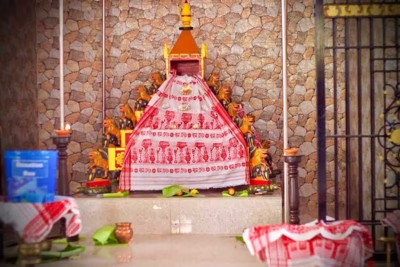
(Source – India Today NE)
Thapona kapur (sanctorum cloth)—the gamusa that is laid on the sanctorum of a naamghar (Vaishnavite prayer hall), right below the sacred scriptures like the Bhagavat and the Kirtan. Moreover, the cloth is also used to cover the scriptures to prevent their damage.
Now, let us look into the elaborate motifs that decorate a gamusa.
Motifs of the Textile
Assamese weavers skillfully incorporate intricate motifs into the gamusa, reflecting symbols and designs deeply connected to the region’s cultural heritage. The motifs can broadly be categorized as naturalistic, stylized, abstract, structural, and geometric, each adding a layer of meaning and artistry to the fabric.
While floral motifs like lotus, vines and paisley designs are common, geometric patterns are another common element, featuring stripes, zigzags, triangles, and diamond shapes, providing rhythm and visual harmony.
Weavers also depict various animals and birds, drawing inspiration from Assam’s rich fauna. Celebrating the region’s biodiversity, common motifs include the peacock, crane, mynah, kingfisher, duck, deer, one-horned rhinoceros (unique to Assam), elephant, and tiger.
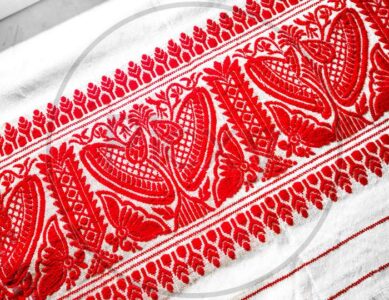
(Source – Picxy)
The Japi motif, representing the traditional Assamese bamboo and cane hat, is another popular design in gamusa, symbolizing Assamese hospitality.
Representation of the Gamusa in Popular Culture
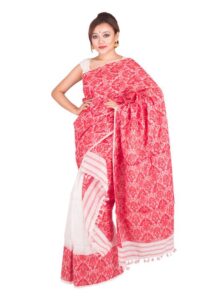
(Source – Pinterest)
The Gamusa, as Assam’s cultural symbol has tremendously gained global recognition over the years. Its motifs and designs have been incorporated by fashion designers into different types of modern clothings like kurta, pajamas, mekhela chadar, and hankerchiefs, showcasing its versatility in popular culture.
Current Status of the Gamusa
At present, this traditional handloom artifact is losing its authenticity due to rapid commercialization and increased market demand for the product. Traditional weavers who are mostly the rural women, are losing their prominence with the rise of power loom gamusas, which are cheaper and quicker to produce. As a result, they are facing economic threats as well as erosion of their artisanal skills that they inherited over generations.

(Source – The News Mill)
While these challenges remain significant, there is now growing awareness among both the Assamese people and the government about the need to preserve the authenticity of the gamusa without allowing its essence to be diluted by imitations and mass-produced alternatives.
The gamusa received the GI tag in December 2022, marking a milestone achievement in safeguarding the authenticity of the craft and honoring the hard work of the traditional handloom weavers.
Conclusion
The gamusa is not just a piece of cloth but a marker of the Assamese identity. The motifs woven into this textile are timeless threads binding a community across generations—they brilliantly embody the aspirations, creativity and resilience of the Assamese rural women weavers. It is the symbol of respect, a token of love, and sometimes even a symbol of resistance. Its evolving nature serves as a living testament to the rich cultural tradition of the region.
References
https://assamgamosa.com/history-of-assamese-gamosa-origin/
https://or.niscpr.res.in/index.php/IJTK/article/view/17210/4029
https://papers.ssrn.com/sol3/Delivery.cfm/SSRN_ID4005823_code4300924.pdf?abstractid=4005823&mirid=1




